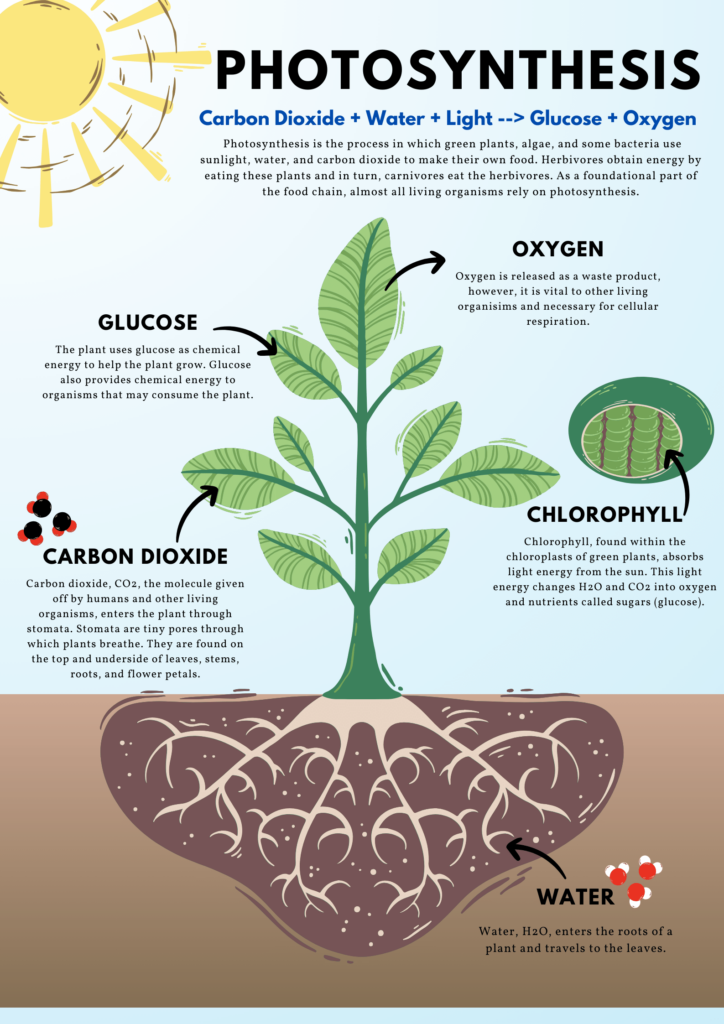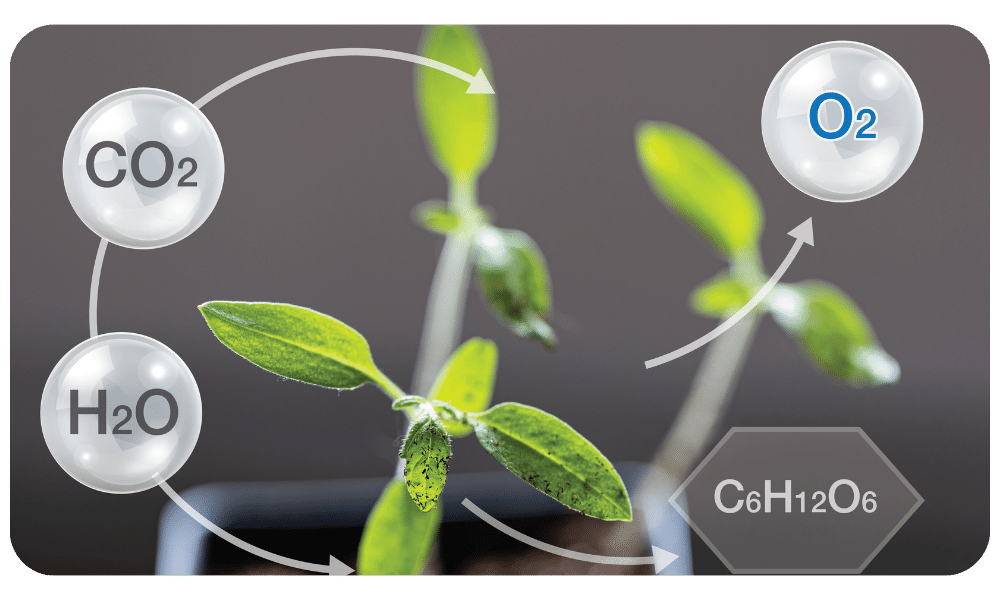Have you ever wondered how those giant trees in the park or the delicious fruits you eat grow big and strong? The answer lies in a fascinating process called photosynthesis! Today, we’ll explore this magical trick plants use to create their own food using sunlight.
What is Photosynthesis?
-
- Photosynthesis is a process by which plants, some algae, and certain bacteria capture energy from sunlight and use it to convert water and carbon dioxide (CO₂) into glucose (sugar) and oxygen (O₂). It’s like tiny factories inside the plant leaves, working hard to produce food!

Here’s a breakdown of the key ingredients:
-
- Sunlight: The main source of energy for photosynthesis. It acts like the fuel that powers the whole process.
-
- Water: Plants absorb water through their roots. It’s one of the raw materials needed for food production.
-
- Carbon Dioxide (CO₂): Plants take in CO₂ from the air through tiny openings on their leaves called stomata. It’s another raw material.
-
- Glucose (Sugar): The end product of photosynthesis. It’s the food that the plant uses for growth, repair, and other functions.
-
- Oxygen (O₂): A byproduct of photosynthesis released back into the atmosphere. It’s the gas we breathe!
The Photosynthesis Factory: Inside a Leaf
Imagine a leaf as a miniature factory with different sections working together:
-
- Chloroplasts: These are the powerhouses of the cell, containing a green pigment called chlorophyll. Chlorophyll acts like a light-absorbing antenna, capturing sunlight’s energy.
-
- Stroma: This is the fluid-filled area within the chloroplast where the captured sunlight energy is used to convert CO₂ and water into glucose.
Step-by-Step Photosynthesis:
-
- Light Capture: Sunlight strikes the chlorophyll in the chloroplasts, exciting its electrons.
-
- Water Splitting: Using the captured energy, the plant splits water molecules into hydrogen ions (H⁺) and oxygen atoms (O). Oxygen is released as a byproduct.
-
- Carbon Fixation: CO₂ from the air enters the leaf through stomata and combines with a molecule called RuBisCO (RuBisco) to form a temporary compound.
-
- The Calvin Cycle: This cycle, happening in the stroma, uses the energy from sunlight captured earlier to convert the temporary compound into glucose.
-
- Food for the Plant: The glucose produced is used by the plant for various functions like growth, repair, and reproduction.
Examples of Photosynthesis in Action:
-
- The Greener the Better: Plants with more chlorophyll can potentially photosynthesize more efficiently, leading to faster growth.
-
- Why Leaves Change Color: In autumn, as days shorten, plants produce less chlorophyll, causing leaves to lose their green color and reveal other pigments like yellow and orange.
-
- Importance of Forests: Forests are vital for healthy ecosystems because they remove CO₂ from the atmosphere through photosynthesis, contributing to a cleaner environment.
Beyond Plants: Photosynthesis in Action!
While plants are the primary “chefs” using photosynthesis, some other organisms also use this process:
-
- Algae: Microscopic algae in oceans and freshwater play a crucial role in marine ecosystems, producing a significant portion of the Earth’s oxygen through photosynthesis.
-
- Cyanobacteria (Blue-green Algae): These ancient bacteria were some of the earliest life forms on Earth, and their photosynthesis likely helped create the oxygen-rich atmosphere we breathe today.
Remember: Photosynthesis is a vital process that sustains life on Earth. Plants not only provide us with food but also produce the oxygen we breathe, making them essential players in a healthy planet!
Mains Questions:

Question 1:
Photosynthesis, the fundamental process by which plants produce their food, is critical for life on Earth. Explain the various stages involved in photosynthesis and discuss its significance for the environment. (250 Words)
Model Answer:
Photosynthesis is the process by which plants, algae, and some bacteria capture sunlight energy and convert it into organic compounds (glucose) and oxygen. This process is vital for life on Earth as it provides the foundation of the food chain and supports respiration in most living organisms.
Stages of Photosynthesis:
-
- Light Capture: Chlorophyll pigments in plant leaves absorb sunlight energy.
- Water Splitting: Using this energy, water molecules are split into hydrogen ions and oxygen. Oxygen is released as a byproduct.
- Carbon Fixation: Carbon dioxide from the air enters the leaf and combines with RuBisCO to form a temporary compound.
- Calvin Cycle: This cycle utilizes the captured sunlight energy to convert the temporary compound into glucose.
Significance of Photosynthesis for the Environment:
-
- Food Production: Photosynthesis is the primary source of food for herbivores, which then become food for carnivores. This forms the base of the food chain, supporting all terrestrial and aquatic life.
- Oxygen Production: Photosynthesis releases oxygen, a vital gas for aerobic respiration in animals and some plants.
- Climate Regulation: Plants absorb carbon dioxide, a greenhouse gas, during photosynthesis, helping to regulate Earth’s climate.
- Habitat Creation: Photosynthesis contributes to healthy ecosystems by providing food and shelter for various organisms.
Question 2:
Explain how human activities can disrupt the delicate balance of photosynthesis and suggest measures to mitigate these disruptions. (250 Words)
Model Answer:
Human activities can disrupt the process of photosynthesis in several ways:
-
- Deforestation: Large-scale deforestation reduces the number of plants available for photosynthesis, leading to decreased oxygen production and increased atmospheric CO₂.
- Air Pollution: Industrial emissions and burning fossil fuels release pollutants that can block sunlight, hindering light capture by plants.
- Climate Change: Rising temperatures and changing precipitation patterns can stress plants, affecting their ability to photosynthesize efficiently.
Mitigating Disruptions:
-
- Afforestation and Reforestation: Planting trees increases the number of plants performing photosynthesis, promoting oxygen production and CO₂ removal.
- Controlling Air Pollution: Implementing stricter emission regulations and promoting renewable energy sources can reduce air pollution and improve light availability for plants.
- Sustainable Practices: Adopting sustainable agricultural practices that minimize deforestation and soil degradation can create a healthier environment for photosynthesis.
By taking these measures, we can ensure the continued functioning of this vital process, maintaining a healthy planet for all living beings.
Attempt Quiz based on above!
Read in Hindi
Remember: These are just sample answers. It’s important to further research and refine your responses based on your own understanding and perspective. Read entire UPSC Current Affairs.
Relevance to the UPSC Prelims and Mains syllabus under the following topics:

Prelims:
-
- Science and Technology: A basic understanding of photosynthesis falls under Science and Technology in the Prelims syllabus. Knowing the concept of photosynthesis, its raw materials, and products (glucose and oxygen) could be marginally helpful.
Mains:
-
- General Studies Paper II (Governance, Constitution, Polity and Social Justice): The potential disruption of photosynthesis due to human activities (like deforestation) can be linked to discussions on environmental issues and their impact on society.
- General Studies Paper III (Technology, Economic Development, Security and Disaster Management): Here, you could discuss the importance of photosynthesis for a healthy ecosystem and the potential consequences of its disruption due to technological advancements (e.g., increased air pollution).
- General Studies Paper IV (Ethics, Integrity and Aptitude): The ethical implications of human activities that threaten the delicate balance of photosynthesis can be analyzed here. You could discuss the importance of sustainable practices to ensure the well-being of future generations.










0 Comments